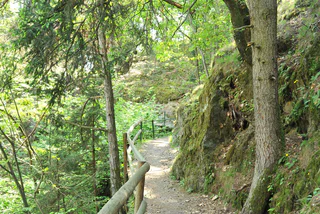
1/5
Path of Contemplation (Besinnungsweg) in Riffian/Rifiano
Magdfeld/Magdfeld, Riffian/Rifiano, Meran/Merano and environs
Všude v prázdninových regionech Jižního Tyrolska jsou vyznačeny tematické procházky, speciální objevitelské trasy pro malé i velké. Například v jihotyrolském Unterlandu mohou návštěvníci na podzim zažít, jak se hrozny dostanou z vinné révy do sudu. V San Valentinu v Campo/Gummeru můžete prozkoumat vesmír a naši sluneční soustavu a v Terlanu/Terlanu pěstitelé chřestu předvedou, jak se na jaře získává ze země vzácný chřest. Celkem na návštěvníky Jižního Tyrolska čeká více než 150 značených a poučných tematických procházek.

1/5
Magdfeld/Magdfeld, Riffian/Rifiano, Meran/Merano and environs

Monteponente/Pfeffersberg, Brixen/Bressanone, Brixen/Bressanone and environs

Riomolino/Mühlbach - Gais, Gais, Ahrntal/Valle Aurina

Pinzano/Pinzon, Montan/Montagna, Alto Adige Wine Road

Anterivo/Altrei, Altrei/Anterivo

1/5
Ortisei/Urtijëi/St. Ulrich/Urtijëi, Urtijëi/Ortisei, Dolomites Region Val Gardena

Fontanefredde/Kaltenbrunn, Truden/Trodena

Fleres/Pflersch, Brenner/Brennero, Sterzing/Vipiteno and environs

Anterivo/Altrei, Altrei/Anterivo

1/4
Certosa/Karthaus, Schnals/Senales, Vinschgau/Val Venosta

1/3
Obereggen/Obereggen, Deutschnofen/Nova Ponente, Dolomites Region Eggental

1/3
Barbiano/Barbian, Barbian/Barbiano, Brixen/Bressanone and environs

Tarres/Tarsch, Latsch/Laces, Vinschgau/Val Venosta

1/2
San Cassiano/San Cassiano, Badia, Dolomites Region Alta Badia

Colle Isarco/Gossensaß, Brenner/Brennero, Sterzing/Vipiteno and environs

1/5
Siusi/Seis, Kastelruth/Castelrotto, Dolomites Region Seiser Alm

Solda/Sulden, Stilfs/Stelvio, Vinschgau/Val Venosta

1/10
Plazzoles/Platzers, Tisens/Tesimo, Meran/Merano and environs

Radein/Redagno, Aldein/Aldino

1/5
Kuens/Caines, Meran/Merano and environs

1/3
Castelbello/Kastelbell, Kastelbell-Tschars/Castelbello-Ciardes, Vinschgau/Val Venosta

1/8
Velloi/Vellau, Algund/Lagundo, Meran/Merano and environs

Piavenna/Plawenn, Graun im Vinschgau/Curon Venosta, Vinschgau/Val Venosta

S. Pietro/St. Peter - Valle Aurina/Ahrntal, Ahrntal/Valle Aurina, Ahrntal/Valle Aurina

1/14
Laghetti/Laag, Neumarkt/Egna, Alto Adige Wine Road

1/8
Oris/Eyrs, Laas/Lasa, Vinschgau/Val Venosta

1/2
Obereggen/Obereggen, Deutschnofen/Nova Ponente, Dolomites Region Eggental

1/6
Mazzon/Mazon, Neumarkt/Egna, Alto Adige Wine Road

1/17
S. Osvaldo/St. Oswald - Bolzano/Bozen, Bolzano/Bozen, Bolzano/Bozen and environs

1/2
Anterselva di Sopra/Antholz-Obertal, Rasen-Antholz/Rasun Anterselva, Dolomites Region Kronplatz/Plan de Corones